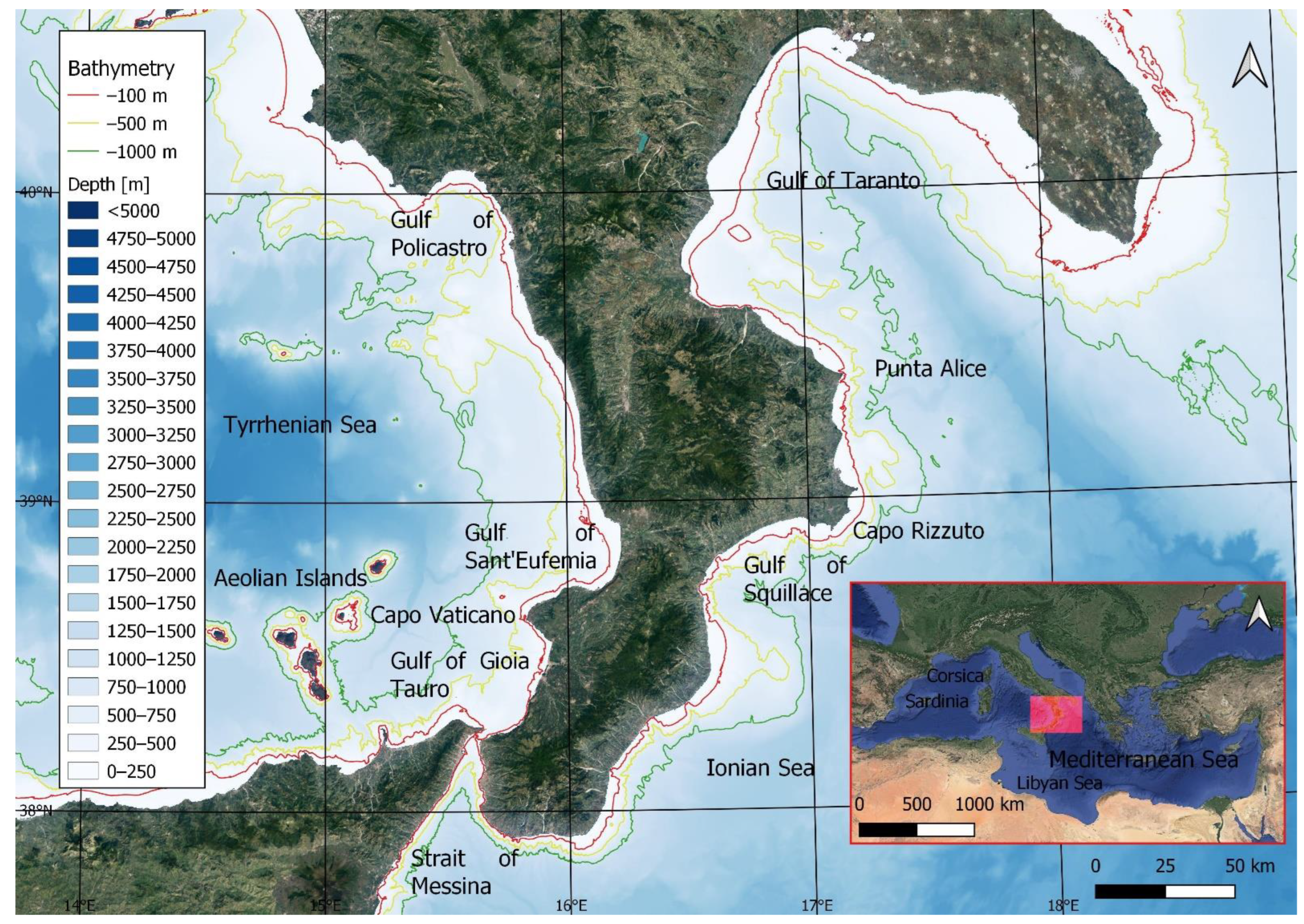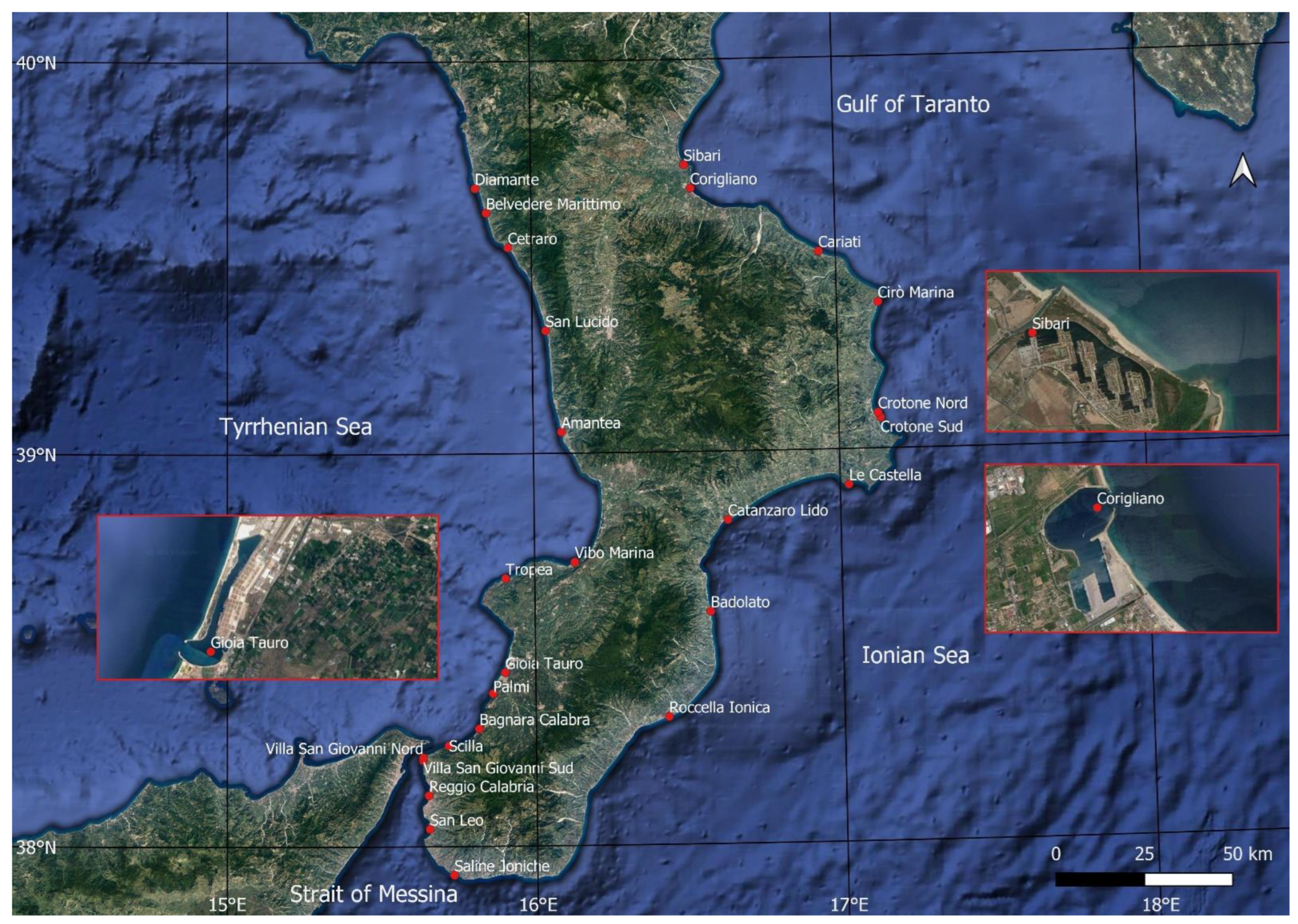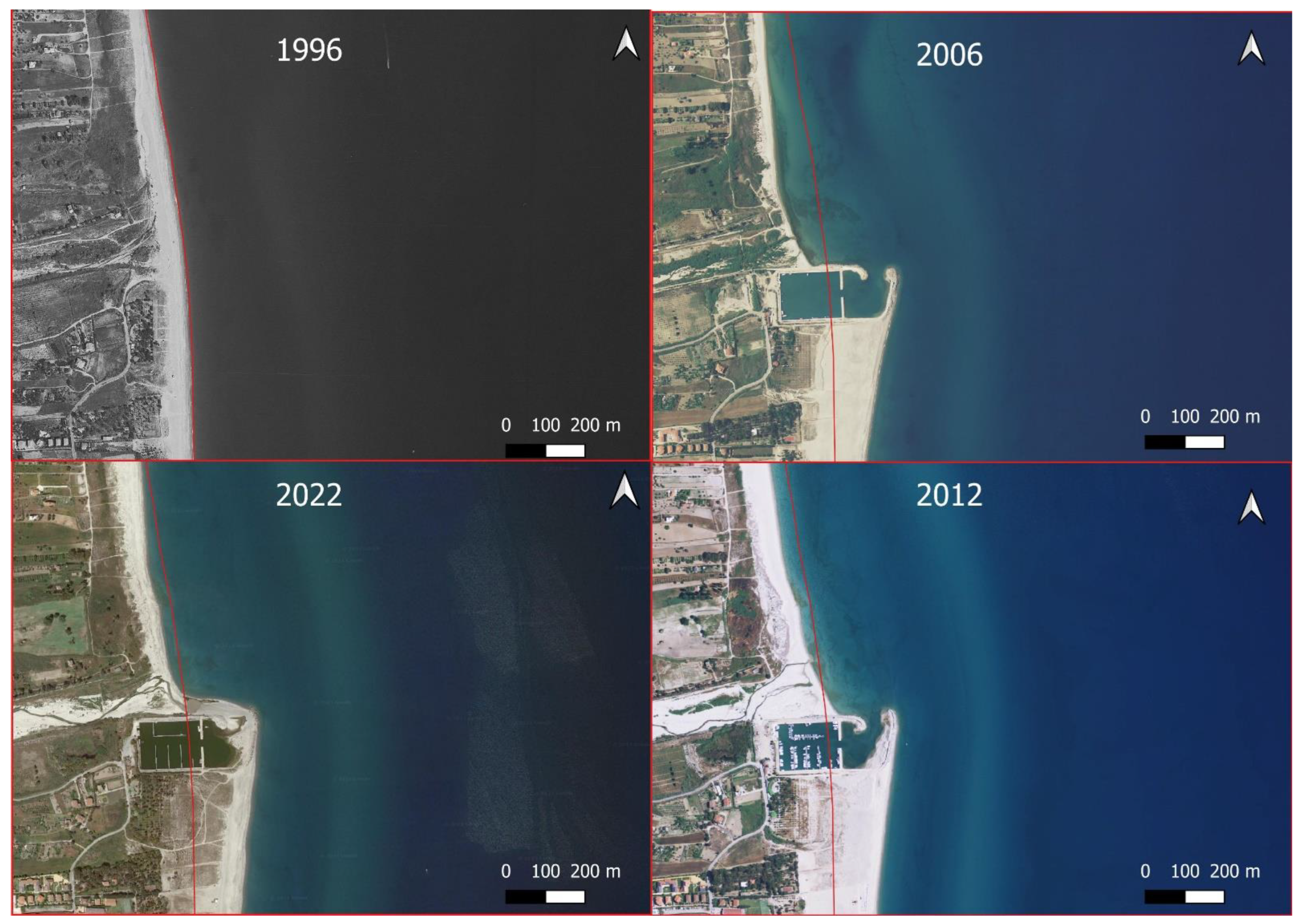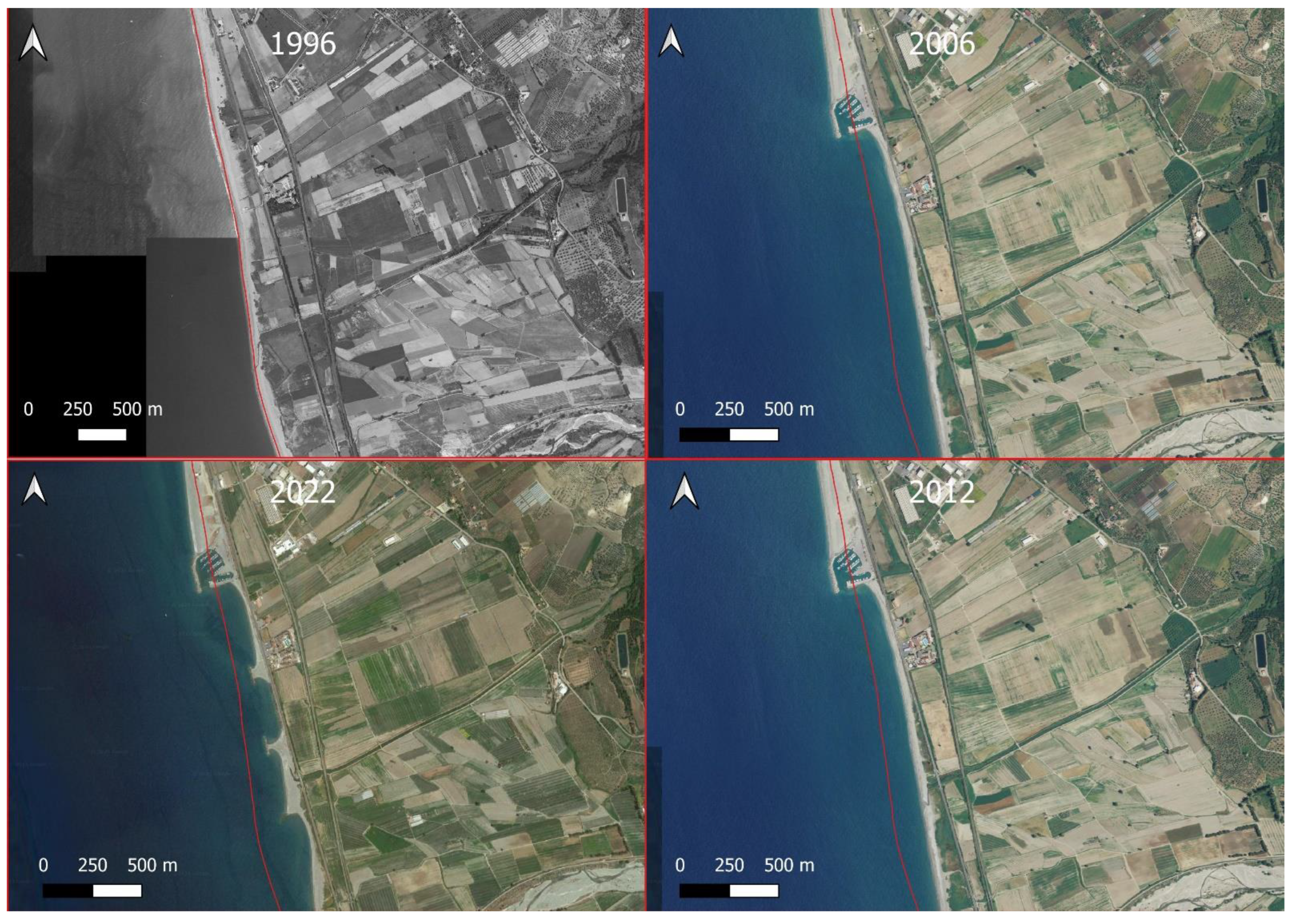Shoreline Changes Due to the Construction of Ports: Case Study—Calabria (Italy)
Abstract
1. Introduction
2. Materials and Methods
2.1. Site Description
2.2. Methodology
- Acquisition of historical and current cartographic data (shapefiles, cartography, and satellite imagery).
- Digitization of the shorelines.
- Classification of the shoreline changes.
- Analysis of the shoreline changes due to the construction of ports.
3. Results
4. Discussion
5. Conclusions
Author Contributions
Funding
Institutional Review Board Statement
Informed Consent Statement
Data Availability Statement
Conflicts of Interest
References
- Bosworth, G.F. Ships, Shipping and Fishing: With Some Account of Our Seaports and Their Industries; University Press: Cambridge, UK, 1915. [Google Scholar]
- Barragán, J.M.; de Andrés, M. Analysis and trends of the world’s coastal cities and agglomerations. Ocean Coast. Manag. 2015, 114, 11–20. [Google Scholar] [CrossRef]
- Romano, B.; Zullo, F.; Fiorini, L.; Marucci, A.; Ciabò, S. Land transformation of Italy due to half a century of urbanization. Land Use Policy 2017, 67, 387–400. [Google Scholar] [CrossRef]
- Sancho, F.; Abreu, T.; D’Alessandro, F.; Tomasicchio, G.R.; Silva, P.A. Surf hydrodynamics under collapsing coastal dunes. J. Coast. Res. 2011, 64, 144–148. [Google Scholar]
- D’Alessandro, F.; Tomasicchio, G.R.; Frega, F.; Carbone, M. Design and management aspects of a coastal protection system. A case history in the South of Italy. J. Coast. Res. 2011, 64, 492–495. [Google Scholar]
- D’Alessandro, F.; Tomasicchio, G.R.; Musci, F.; Ricca, A. Dune erosion physical, analytical and numerical modelling. In Proceedings of the 33rd International Conference on Coastal Engineering, Santander, Spain, 1–6 July 2012. [Google Scholar] [CrossRef]
- Pagán, J.I.; Aragonés, L.; Tenza-Abril, A.J.; Pallarés, P. The influence of anthropic actions on the evolution of an urban beach: Case study of Marineta Cassiana beach, Spain. Sci. Total Environ. 2016, 559, 242–255. [Google Scholar] [CrossRef] [PubMed]
- Brazner, J.C.; Danz, N.P.; Niemi, G.J.; Regal, R.R.; Trebitz, A.S.; Howe, R.W.; Hanowski, J.M.; Johnson, L.B.; Yi, L.; Chen, J.S.; et al. Impacts of human activities on coastal ecological environment during the rapid urbanization process in Shenzhen, China. Ocean Coast. Manag. 2018, 154, 121–132. [Google Scholar] [CrossRef]
- Luijendijk, A.; Hagenaars, G.; Ranasinghe, R.; Baart, F.; Donchyts, G.; Aarninkhof, S. The state of the world’s beaches. Sci. Rep. 2018, 8, 6641. [Google Scholar] [CrossRef]
- Aguilera, M.A.; Tapia, J.; Gallardo, C.; Núñez, P.; Varas-Belemmi, K. Loss of coastal ecosystem spatial connectivity and services by urbanization: Natural-to-urban integration for bay management. J. Environ. Manag. 2020, 276, 111297. [Google Scholar] [CrossRef]
- Zhai, T.; Wang, J.; Fang, Y.; Qin, Y.; Huang, L.; Chen, Y. Assessing ecological risks caused by human activities in rapid urbanization coastal areas: Towards an integrated approach to determining key areas of terrestrial-oceanic ecosystems preservation and restoration. Sci. Total Environ. 2020, 708, 135153. [Google Scholar] [CrossRef]
- Yi, L.; Yu, Z.; Qian, J.; Kobuliev, M.; Chen, C.; Xing, X. Evaluation of the heterogeneity in the intensity of human interference on urbanized coastal ecosystems: Shenzhen (China) as a case study. Ecol. Indic. 2021, 122, 107243. [Google Scholar] [CrossRef]
- Bombino, G.; Barbaro, G.; D’Agostino, D.; Denisi, P.; Foti, G.; Labate, A.; Zimbone, S.M. Shoreline change and coastal erosion: The role of check dams. First indications from a case study in Calabria, Southern Italy. Catena 2022, 217, 106494. [Google Scholar] [CrossRef]
- Foti, G.; Barbaro, G.; Barilla, G.C.; Frega, F. Effects of Anthropogenic Pressures on Dune Systems–Case Study: Calabria (Italy). J. Mar. Sci. Eng. 2022, 10, 10. [Google Scholar] [CrossRef]
- Chen, H.; Huang, F.; Hu, W.; Wang, C.; Zhong, L. A procedure for comparing the ecological status and transformation measures in an anthropized coastal area. J. Environ. Manag. 2022, 301, 113928. [Google Scholar] [CrossRef] [PubMed]
- Komar, P.D. Coastal erosion–underlying factors and human impacts. Shore Beach 2000, 68, 3–16. [Google Scholar]
- Kudale, M.D. Impact of port development on the coastline and the need for protection. Ind. J. Geo-Mar. Sci. 2010, 39, 597–604. [Google Scholar]
- van Rijn, L.C. Coastal erosion and control. Ocean Coast. Manag. 2011, 54, 867–887. [Google Scholar] [CrossRef]
- Addo, K.A. Shoreline morphological changes and the human factor. Case study of Accra Ghana. J. Coast. Conserv. 2013, 17, 85–91. [Google Scholar] [CrossRef]
- Barbaro, G. Saline Joniche: A predicted disaster. Disaster Adv. 2013, 6, 1–3. [Google Scholar]
- Sarma, K.G.S. Siltation and Coastal Erosion at Shoreline Harbours. Procedia Eng. 2015, 116, 12–19. [Google Scholar] [CrossRef]
- Prumm, M.; Iglesias, G. Impacts of port development on estuarine morphodynamics: Ribadeo (Spain). Ocean Coast. Manag. 2016, 130, 58–72. [Google Scholar] [CrossRef]
- Miduri, M.; Foti, G.; Puntorieri, P. Impact generated by Marina of Badolato (Italy) on adjacent coast. In Proceedings of the 13th International Congress on Coastal and Marine Sciences, Engineering, Management and Conservation MEDCOAST, Mellieha, Malta, 31 October–4 November 2017; Volume 2, pp. 935–945. [Google Scholar]
- Williams, A.T.; Rangel-Buitrago, N.; Pranzini, E.; Anfuso, G. The management of coastal erosion. Ocean Coast. Manag. 2017, 156, 4–20. [Google Scholar] [CrossRef]
- Tomasicchio, G.R.; Francone, A.; Simmonds, D.J.; D’Alessandro, F.; Frega, F. Prediction of shoreline evolution. Reliability of a general model for the mixed beach case. J. Mar. Sci. Eng. 2020, 8, 361. [Google Scholar] [CrossRef]
- Rodríguez-Santalla, I.; Roca, M.; Martinez-Clavel, B.; Pablo, M.; Moreno-Blasco, L.; Blázquez, A.M. Coastal changes between the harbours of Castellón and Sagunto (Spain) from the mid-twentieth century to present. Reg. Stud. Mar. Sci. 2021, 46, 101905. [Google Scholar] [CrossRef]
- Foti, G.; Barbaro, G.; Barillà, G.C.; Mancuso, P.; Puntorieri, P. Shoreline evolutionary trends along calabrian coasts: Causes and classification. Front. Mar. Sci. 2022, 9, 846914. [Google Scholar] [CrossRef]
- Günaydın, K.; Kabdaşlı, M.S. Characteristics of coastal erosion geometry under regular and irregular waves. Ocean Eng. 2003, 30, 1579–1593. [Google Scholar] [CrossRef]
- Li, X.; Zhou, Y.; Zhang, L.; Kuang, R. Shoreline change of Chongming Dongtan and response to river sediment load: A remote sensing assessment. J. Hydrol. 2014, 511, 432–442. [Google Scholar] [CrossRef]
- Almar, R.; Kestenare, E.; Reyns, J.; Jouanno, J.; Anthony, E.; Laibi, R.; Hemer, M.A.; du Penhoat, Y.; Ranasinghe, R. Response of the Bight of Benin (Gulf of Guinea, West Africa) coastline to anthropogenic and natural forcing, Part 1: Wave climate variability and impacts on the longshore sediment transport. Cont. Shelf Res. 2015, 110, 48–59. [Google Scholar] [CrossRef]
- Dada, O.A.; Qiao, L.; Ding, D.; Li, G.; Ma, Y.; Wang, L. Evolutionary trends of the Niger Delta shoreline during the last 100 years: Responses to rainfall and river discharge. Mar. Geol. 2015, 367, 202–211. [Google Scholar] [CrossRef]
- Bacino, G.L.; Dragani, W.C.; Codignotto, J.O. Changes in wave climate and its impact on the coastal erosion in Samborombón Bay, Río de la Plata estuary, Argentina. Estuar. Coast. Shelf Sci. 2019, 219, 71–80. [Google Scholar] [CrossRef]
- Barbaro, G.; Bombino, G.; Foti, G.; Borrello, M.M.; Puntorieri, P. Shoreline evolution near river mouth: Case study of Petrace River (Calabria, Italy). Reg. Stud. Mar. Sci. 2019, 29, 100619. [Google Scholar] [CrossRef]
- Foti, G.; Barbaro, G.; Bombino, G.; Fiamma, V.; Puntorieri, P.; Minniti, F.; Pezzimenti, C. Shoreline changes near river mouth: Case study of Sant’Agata River (Reggio Calabria, Italy). Eur. J. Remote Sens. 2019, 52 (Suppl. 4), 102–112. [Google Scholar] [CrossRef]
- Marchesiello, P.; Nguyen, N.M.; Gratiot, N.; Loisel, H.; Anthony, E.J.; Dinh, C.S.; Nguyen, T.; Almar, R.; Kestenare, E. Erosion of the coastal Mekong delta: Assessing natural against man induced processes. Cont. Shelf Res. 2019, 181, 72–89. [Google Scholar] [CrossRef]
- Wang, J.; You, Z.J.; Liang, B. Laboratory investigation of coastal beach erosion processes under storm waves of slowly varying height. Mar. Geol. 2020, 430, 106321. [Google Scholar] [CrossRef]
- Ngowo, R.G.; Ribeiro, M.C.; Pereira, M.J. Quantifying 28-year (1991–2019) shoreline change trends along the Mnazi Bay–Ruvuma Estuary Marine Park, Tanzania. Remote Sens. Appl. Soc. Environ. 2021, 23, 100607. [Google Scholar] [CrossRef]
- Fiori, E.; Comellas, A.; Molini, L.; Rebora, N.; Siccardi, F.; Gochis, D.J.; Tanelli, S.; Parodi, A. Analysis and hindcast simulations of an extreme rainfall event in the Mediterranean area: The Genoa 2011 case. Atmos. Res. 2014, 138, 13–29. [Google Scholar] [CrossRef]
- Zellou, B.; Rahali, H. Assessment of the joint impact of extreme rainfall and storm surge on the risk of flooding in a coastal area. J. Hydrol. 2019, 569, 647–665. [Google Scholar] [CrossRef]
- Canale, C.; Barbaro, G.; Petrucci, O.; Fiamma, V.; Foti, G.; Barillà, G.C.; Puntorieri, P.; Minniti, F.; Bruzzaniti, L. Analysis of floods and storms: Concurrent conditions. Ital. J. Eng. Geol. Environ. 2020, 1, 23–29. [Google Scholar]
- Canale, C.; Barbaro, G.; Foti, G.; Petrucci, O.; Besio, G.; Barillà, G.C. Bruzzano river mouth damage due to meteorological events. Int. J. River Basin Manag. 2022, 20, 499–515. [Google Scholar] [CrossRef]
- Palazzo, F.; Latini, D.; Baiocchi, V.; Del Frate, F.; Giannone, F.; Dominici, D.; Remondiere, S. An application of COSMO-SkyMed to coastal erosion studies. Eur. J. Remote Sens. 2012, 45, 361–370. [Google Scholar] [CrossRef]
- Braga, F.; Tosi, L.; Prati, C.; Alberotanza, L. Shoreline detection: Capability of COSMO-SkyMed and high-resolution multispectral. Eur. J. Remote Sens. 2013, 46, 837–853. [Google Scholar] [CrossRef]
- Ayadi, K.; Boutiba, M.; Sabatier, F.; Guettouche, M.S. Detection and analysis of historical variations in the shoreline, using digital aerial photos, satellite images, and topographic surveys DGPS: Case of the Bejaia bay (East Algeria). Arab. J. Geosci. 2016, 9, 26. [Google Scholar] [CrossRef]
- Gonçalves, G.; Santos, S.; Duarte, D.; Gomes, J. Monitoring Local Shoreline Changes by Integrating UASs, Airborne LiDAR, Historical Images and Orthophotos. In GISTAM; Heraklion: Crete, Greece, 2019; pp. 126–134. [Google Scholar] [CrossRef]
- Mao, Y.; Harris, D.L.; Xie, Z.; Phinn, S. Efficient measurement of large-scale decadal shoreline change with increased accuracy in tide-dominated coastal environments with Google Earth Engine. ISPRS J. Photogramm. Remote Sens. 2021, 181, 385–399. [Google Scholar] [CrossRef]
- Pardo-Pascual, J.E.; Almonacid-Caballer, J.; Ruiz, L.A.; Palomar-Vázquez, J. Automatic extraction of shorelines from Landsat TM and ETM+ multi-temporal images with subpixel precision. Remote Sens. Environ. 2012, 123, 1–11. [Google Scholar] [CrossRef]
- Maglione, P.; Parente, C.; Vallario, A. High resolution satellite images to reconstruct recent evolution of domitian coastline. Am. J. Appl. Sci. 2015, 12, 506–515. [Google Scholar] [CrossRef][Green Version]
- George, P.P.; Dionissios, K.P.; Hywel, G.M.; Paraskevi, D.P. Remote sensing and GIS analysis for mapping spatio-temporal changes of erosion and deposition of two Mediterranean river deltas: The case of the Axios and Aliakmonas rivers, Greece. Int. J. Appl. Earth Obs. Geoinf. 2015, 35, 217–228. [Google Scholar] [CrossRef]
- Asib, A.; Frances, D.; Rizwan, N.; Clare, W. Where is the coast? Monitoring coastal land dynamics in Bangladesh: An integrated management approach using GIS and remote sensing techniques. Ocean Coast. Manag. 2018, 151, 10–24. [Google Scholar] [CrossRef]
- Hossain, M.S.; Yasir, M.; Wang, P.; Ullah, S.; Jahan, M.; Hui, S.; Zhao, Z. Automatic shoreline extraction and change detection: A study on the southeast coast of Bangladesh. Mar. Geol. 2021, 441, 106628. [Google Scholar] [CrossRef]
- Moore, L.J. Shoreline mapping techniques. J. Coast. Res. 2000, 16, 111–124. [Google Scholar]
- Mills, J.P.; Buckley, S.J.; Mitchell, H.L.; Clarke, P.J.; Edwards, J. A geomatics data integration technique for coastal change monitoring. Earth Surf. Process. Landf. 2005, 30, 651–664. [Google Scholar] [CrossRef]
- Alesheikh, A.A.; Ghorbanali, A.; Nouri, N. Coastline change detection using remote sensing. Int. J. Environ. Sci. Technol. 2007, 4, 61–66. [Google Scholar] [CrossRef]
- Maiti, S.; Bhattacharya, A.K. Shoreline change analysis and its application to prediction: A remote sensing and statistics based approach. Mar. Geol. 2009, 257, 11–23. [Google Scholar] [CrossRef]
- Louati, M.; Saïdi, H.; Zargouni, F. Shoreline change assessment using remote sensing and GIS techniques: A case study of the Medjerda delta coast, Tunisia. Arab. J. Geosci. 2015, 8, 4239–4255. [Google Scholar] [CrossRef]
- Moussaid, J.; Fora, A.A.; Zourarah, B.; Maanan, M.; Maanan, M. Using automatic computation to analyze the rate of shoreline change on the Kenitra coast, Morocco. Ocean Eng. 2015, 102, 71–77. [Google Scholar] [CrossRef]
- Anand, R.; Chandrasekar, N.; Kaliraj, S.; Magesh, N.S. Shoreline change rate and erosion risk assessment along the Trou Aux Biches—Mont Choisy beach on the northwest coast of Mauritius using GIS-DSAS technique. Environ. Earth Sci. 2016, 75, 444. [Google Scholar] [CrossRef]
- Fatima, S.; Mohammed, H.; Lech-Hab, H.; Ahmed, R.; Abdelkrim, A. Application of a geomatics approach for the diachronic study of the Mediterranean coastline case of Tangier Bay. Int. J. Geosci. 2018, 9, 320–336. [Google Scholar] [CrossRef][Green Version]
- Hashmi, S.G.M.D.; Ahmad, S.R. GIS-based analysis and modeling of coastline erosion and accretion along the Coast of Sindh Pakistan. J. Coast. Zone Manag. 2018, 21, 1000455. [Google Scholar] [CrossRef]
- Awad, M.; El-Sayed, H.M. The analysis of shoreline change dynamics and future predictions using automated spatial techniques: Case of El-Omayed on the Mediterranean coast of Egypt. Ocean Coast. Manag. 2021, 205, 105568. [Google Scholar] [CrossRef]
- Apostolopoulos, D.; Nikolakopoulos, K. A review and meta-analysis of remote sensing data, GIS methods, materials and indices used for monitoring the coastline evolution over the last twenty years. Eur. J. Remote Sens. 2021, 54, 240–265. [Google Scholar] [CrossRef]
- Matin, N.; Hasan, G.J. A quantitative analysis of shoreline changes along the coast of Bangladesh using remote sensing and GIS techniques. Catena 2021, 201, 105185. [Google Scholar] [CrossRef]
- Foti, G.; Barbaro, G.; Besio, G.; Barillà, G.C.; Mancuso, P.; Puntorieri, P. Wave Climate along Calabrian Coasts. Climate 2022, 10, 80. [Google Scholar] [CrossRef]
- Aceto, L.; Caloiero, T.; Pasqua, A.; Petrucci, O. Analysis of damaging hydrogeological events in a Mediterranean region (Calabria). J. Hydrol. 2016, 541, 510–522. [Google Scholar] [CrossRef]
- Fiorini, L.; Zullo, F.; Marucci, A.; Romano, B. Land take and landscape loss: Effect of uncontrolled urbanization in Southern Italy. J. Urban Manag. 2019, 8, 42–56. [Google Scholar] [CrossRef]
- Cantasano, N.; Pellicone, G.; Ietto, F. The coastal sustainability standard method: A case study in Calabria (southern Italy). Ocean Coast. Manag. 2020, 183, 104962. [Google Scholar] [CrossRef]
- Foti, G.; Barbaro, G.; Barillà, G.C.; Mancuso, P.; Puntorieri, P. Shoreline erosion due to anthropogenic pressure in Calabria (Italy). Eur. J. Remote Sens. 2022, 1–21. [Google Scholar] [CrossRef]
- Boak, E.H.; Turner, I.L. Shoreline definition and detection: A review. J. Coast. Res. 2005, 21, 688–703. [Google Scholar] [CrossRef]
- Hapke, C.J.; Himmelstoss, E.A.; Kratzmann, M.G.; List, J.H.; Thieler, E.R. National Assessment of Shoreline Change: Historical Shoreline Change along the New England and Mid-Atlantic Coasts; Open-File Report 1118; US Geological Survey: Reston, VA, USA, 2010. [Google Scholar] [CrossRef]
- Del Rio, L.; Garcia, F.J. Error determination in the photogrammetric assessment of shoreline changes. Nat. Hazard 2013, 65, 238–2397. [Google Scholar] [CrossRef]
- Allan, J.C.; Komar, P.D.; Priest, G.R. Shoreline variability on the high-energy Oregon coast and its usefulness in erosion-hazard assessments. J. Coast. Res. 2003, 38, 83–105. [Google Scholar]
- Istituto Idrografico della Marina. Tavole di Marea e Delle Correnti di Marea; Istituto Idrografico della Marina Italiana: Genova, Italy, 2020; 144p, (In Italian). ISBN 97888. [Google Scholar]
- Sannino, G.; Carillo, A.; Pisacane, G.; Naranjo, C. On the relevance of tidal forcing in modeling the Mediterranean thermohaline circulation. Prog. Oceanogr. 2015, 134, 304–329. [Google Scholar] [CrossRef]
- Regione Calabria. Indagine conoscitiva dello stato delle coste calabresi, predisposizione di una banca dati dell’evoluzione del litorale e individuazione delle aree a rischio e delle tipologie di intervento. In Studi Su Aree Campione E Previsione Delle Relative Opere; Rapporto finale; Regione Calabria: Catanzaro, Italy, 2003. (In Italian) [Google Scholar]
- Wentworth, C.K. A scale of grade and class terms for clastic sediments. J. Geol. 1922, 30, 377–392. [Google Scholar] [CrossRef]
- Ayalke, Z.G.; Şişman, A.; Akpinar, K. Shoreline extraction and analyzing the effect of coastal structures on shoreline changing with remote sensing and geographic information system: Case of Samsun, Turkey. Reg. Stud. Mar. Sci. 2023, 61, 102883. [Google Scholar] [CrossRef]
- Dev, S.D.; Deepchand, V.; Anoop, M.S.; Krishnaprasad, P.K.; Nazeer, M.N.; Singh, Y.; Arjun, S.; Prasanth, R.S. Influence of a fishing harbour on coastal geomorphology of the southwest coast of India and predictions of its future trends. Geosyst. Geoenviron. 2023, 2, 100179. [Google Scholar] [CrossRef]
- Franklin, G.L.; Medellín, G.; Appendini, C.M.; Gómez, J.A.; Torres-Freyermuth, A.; González, J.L.; Ruiz-Salcines, P. Impact of port development on the northern Yucatan Peninsula coastline. Reg. Stud. Mar. Sci. 2021, 45, 101835. [Google Scholar] [CrossRef]
- Žilinskas, G.; Janušaitė, R.; Jarmalavičius, D.; Pupienis, D. The impact of Klaipėda Port entrance channel dredging on the dynamics of coastal zone, Lithuania. Oceanologia 2020, 62, 489–500. [Google Scholar] [CrossRef]
- Mohanty, P.K.; Barik, S.K.; Kar, P.K.; Behera, B.; Mishra, P. Impacts of ports on shoreline change along Odisha coast. Procedia Eng. 2015, 116, 647–654. [Google Scholar] [CrossRef]
- Uda, T.; Onaka, S.; Serizawa, M. Beach erosion downcoast of Pengambengan fishing port in western part of Bali Island. Procedia Eng. 2015, 116, 494–501. [Google Scholar] [CrossRef]
- Zema, D.A.; Bombino, G.; Boix-Fayos, C.; Tamburino, V.; Zimbone, S.M.; Fortugno, D. Evaluation and modeling of scouring and sedimentation around check dams in a Mediterranean torrent in Calabria, Italy. J. Soil Water Conserv. 2014, 69, 316–329. [Google Scholar] [CrossRef]
- Fortugno, D.; Boix-Fayos, C.; Bombino, G.; Denisi, P.; Quinonero Rubio, J.M.; Tamburino, V.; Zema, D.A. Adjustments in channel morphology due to land-use changes and check dam installation in mountain torrents of Calabria (southern Italy). Earth Surf. Process. Landf. 2017, 42, 2469–2483. [Google Scholar] [CrossRef]
- Gavrilovic, S. A method for estimating the average annual quantity of sediments according to the potency of erosion. Bull. Fac. For. 1962, 26, 151–168. (In Serbian) [Google Scholar]
- Gavrilovic, S. Modern ways of calculating the torrential sediment and erosion mapping. In Erosion, Torrents and Alluvial Deposits Proceedings; Yugoslav Committee for International Hydrological Decade: Belgrade, Serbia, 1970; Volume 1, pp. 85–100. (In Serbian) [Google Scholar]
- Gavrilovic, S. Engineering of torrents and erosion. J. Constr. 1972. (In Serbian) [Google Scholar]
- Arena, F.; Barbaro, G.; Fiamma, V.; Filianoti, P.; Sclavo, M. Indagini preliminari per la soluzione del problema del porto di Saline. In Proceedings of the VI Convegno AIPCN “Giornate italiane di Ingegneria Costiera”, Salerno, Italy, 7–9 November 2001; pp. 127–136. [Google Scholar]






| Port | ID | PC | CT | TBS | CPS | Siltation |
|---|---|---|---|---|---|---|
| Cariati | I1 | 1954–1989 | Bay | Pebble and very coarse sand | 1989–1996 3 | |
| Cirò Marina | I2 | 1989–1996 | Straight | Pebble and coarse sand | 1989–1996 4 | |
| Crotone nord | I3 | before 1954 1 | Bay | Coarse sand | 1954–1989 | |
| Crotone sud | I4 | before 1954 | Bay | Coarse sand | ||
| Le Castella | I5 | 1989–1996 | High Coast | Boulder | 2006–2012 | |
| Catanzaro Lido | I6 | 1954–1989 | Bay | Sand and cobble | 1989–1996 | 2006–2012 |
| Badolato | I7 | 2000–2006 | Straight | Sand and cobble | 1954–1989 | 2000–2006 |
| Roccella Ionica | I8 | 1954–1989 | Straight | Coarse sand | 2017–2018 | |
| Saline Joniche | I9 | 1954–1989 | Straight | Very coarse sand | ||
| San Leo | S1 | 2008–2012 | Bay | Sand and cobble | ||
| Reggio Calabria | S2 | before 1954 | Bay | Sand and cobble | 1989–1996 | |
| Villa San Giovanni sud | S3 | before 1954 | Straight | Sand and cobble | 2014–2017 | |
| Villa San Giovanni nord | S4 | 2008–2012 | Straight | Sand and cobble | 1954–1989 | |
| Scilla | T1 | before 1954 2 | Bay | Pebble and cobble | ||
| Bagnara Calabra | T2 | 1954–1989 | Bay | Pebble and cobble | ||
| Palmi | T3 | 2000–2006 | Bay | Coarse sand | ||
| Tropea | T4 | 1954–1989 | Bay | Coarse sand | ||
| Vibo Marina | T5 | before 1954 | Bay | Very coarse sand | ||
| Amantea | T6 | 2000–2006 | Straight | Pebble and coarse sand | ||
| San Lucido | T7 | 1989–1996 | Inside CPS | Pebble and very coarse sand | ||
| Cetraro | T8 | 1954–1989 | Bay | Pebble and coarse sand | ||
| Belvedere Marittimo | T9 | 2000–2006 | Inside CPS | Medium sand | ||
| Diamante | T10 | 1954–1989 | Bay | Medium sand |
| ID | Depth [m] | SRC | SRCY | SEP [%] | SAC | SACY |
|---|---|---|---|---|---|---|
| I1 | 7 | Intense | 2008 | 75 | Severe | 1989 |
| I2 | 5 | Intense | 2021 | 88 | Moderate | 2008 |
| I3 | 4 | Intense | 1989 | 74 | ||
| I6 | 11 | Intense | 1996 | 57 | Severe | 2012 |
| I7 | 2 | Severe | 2022 | 71 | Severe | 2022 |
| I8 | 8 | Intense | 2019 | 62 | Severe | 2008 |
| I9 | 17 | Severe | 2008 | 95 | Severe | 1989 |
| S1 | 9 | Slight | 2021 | 33 | Slight | 2021 |
| T2 | 15 | Intense | 2021 | 74 | ||
| T3 | 8 | Slight | 2019 | 33 | Slight | 2019 |
| T4 | 7 | Moderate | 1989 | 53 | ||
| T6 | 5 | Severe | 2022 | 93 | Severe | 2006 |
| T8 | 4 | Intense | 1989 | 57 | Intense | 2012 |
| ID | hs,max [m] | hs,av [m] | ∆h1–100 [m] | Ф [kW/m] | MS | α [°] |
|---|---|---|---|---|---|---|
| I1 | 6.18 | 0.57 | 2.46 | 3.4 | 0 | 145 |
| I2 | 7.42 | 0.79 | 3.08 | 7.1 | 140 | 130 |
| I3 | 7.34 | 0.8 | 3.1 | 7.4 | 140 | 35 |
| I6 | 6.28 | 0.68 | 3.01 | 5.1 | 130 | 55 |
| I7 | 6.51 | 0.71 | 3.27 | 5.9 | 130 | 45 |
| I8 | 6.37 | 0.69 | 2.85 | 5.5 | 130 | 55 |
| I9 | 6.39 | 0.78 | 2.69 | 6 | 120 | 15 |
| T2 | 6.71 | 0.48 | 3.34 | 3.10 | 310 | 85 |
| T3 | 8.29 | 0.62 | 3.64 | 5.20 | 300 | 100 |
| T4 | 9.22 | 0.69 | 4.02 | 6.80 | 290 | 25 |
| T6 | 9.58 | 0.73 | 3.97 | 7.60 | 270 | 105 |
| T8 | 9.49 | 0.80 | 3.84 | 8.40 | 260 | 120 |
Disclaimer/Publisher’s Note: The statements, opinions and data contained in all publications are solely those of the individual author(s) and contributor(s) and not of MDPI and/or the editor(s). MDPI and/or the editor(s) disclaim responsibility for any injury to people or property resulting from any ideas, methods, instructions or products referred to in the content. |
© 2023 by the authors. Licensee MDPI, Basel, Switzerland. This article is an open access article distributed under the terms and conditions of the Creative Commons Attribution (CC BY) license (https://creativecommons.org/licenses/by/4.0/).
Share and Cite
Foti, G.; Barbaro, G.; Barillà, G.C.; Mancuso, P. Shoreline Changes Due to the Construction of Ports: Case Study—Calabria (Italy). J. Mar. Sci. Eng. 2023, 11, 2382. https://doi.org/10.3390/jmse11122382
Foti G, Barbaro G, Barillà GC, Mancuso P. Shoreline Changes Due to the Construction of Ports: Case Study—Calabria (Italy). Journal of Marine Science and Engineering. 2023; 11(12):2382. https://doi.org/10.3390/jmse11122382
Chicago/Turabian StyleFoti, Giandomenico, Giuseppe Barbaro, Giuseppina Chiara Barillà, and Pierluigi Mancuso. 2023. "Shoreline Changes Due to the Construction of Ports: Case Study—Calabria (Italy)" Journal of Marine Science and Engineering 11, no. 12: 2382. https://doi.org/10.3390/jmse11122382
APA StyleFoti, G., Barbaro, G., Barillà, G. C., & Mancuso, P. (2023). Shoreline Changes Due to the Construction of Ports: Case Study—Calabria (Italy). Journal of Marine Science and Engineering, 11(12), 2382. https://doi.org/10.3390/jmse11122382










